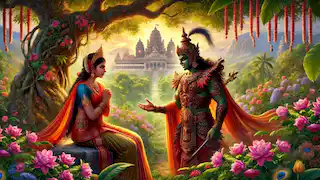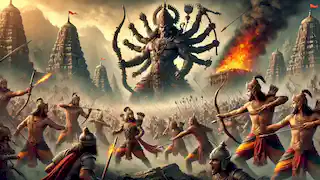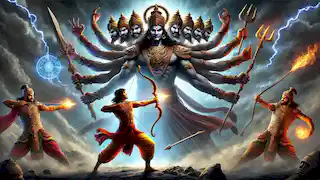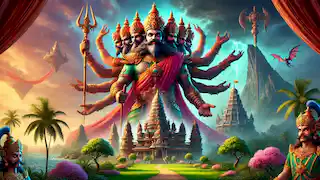Introduction
The legend of Ravana, the Demon King of Lanka, is one of the most captivating and complex tales in Indian mythology. Known primarily for his pivotal role in the epic Ramayana, Ravana is often portrayed as a villain, a ten-headed monster consumed by arrogance and desire. Yet, beneath the surface of this legendary figure lies a multifaceted personality—one who was a learned scholar, an ardent devotee of Shiva, and a ruler of immense power. His story is not merely one of conflict and destruction, but also of ambition, pride, and the tragic downfall that follows hubris.
This tale, set in the ancient world of gods, demons, and humans, speaks of love, betrayal, war, and redemption. Ravana, though demonized in popular retellings, emerges as a character whose strengths and flaws mirror the complexity of human nature. Through his journey, we explore themes of power, spirituality, morality, and fate, all intertwined in the grand tapestry of ancient Indian lore.
The Rise of Ravana
Ravana’s origins are as grand as his eventual demise. Born to a Brahmin sage named Vishrava and a Rakshasi (demoness) named Kaikesi, Ravana inherited the intellectual prowess of his father and the demonic power of his mother. From a young age, he displayed exceptional strength and wisdom, mastering the Vedas and other sacred texts. However, it was his devotion to Lord Shiva, the god of destruction, that set him apart from others.
Ravana’s devotion was so intense that he once performed a severe penance to please Shiva. He stood on Mount Kailash, the abode of the god, and prayed without moving for years. To test his resolve, Shiva caused a massive avalanche, burying Ravana under a mountain of snow. Yet, undeterred, Ravana played his veena—a stringed instrument—composed of his own body, singing hymns in praise of Shiva. His voice echoed through the mountains, causing Shiva to smile in admiration. Pleased with his devotion, Shiva granted Ravana immense power, making him nearly invincible.
With these newfound abilities, Ravana's ambitions soared. He sought to expand his kingdom and power, ruling over Lanka, an island of unparalleled beauty and wealth. His rule was marked by prosperity, technological advancements, and a highly disciplined army of demons. However, as Ravana’s power grew, so did his arrogance.

The Abduction of Sita
Ravana’s encounter with Sita, the wife of Lord Rama, would mark the beginning of his downfall. The story unfolds when Sita, along with her husband Rama and his brother Lakshmana, was living in exile in the forests of Dandaka. Ravana’s sister, Shurpanakha, had encountered Rama in the forest and became infatuated with him. However, when Rama rejected her advances, and Lakshmana, in defense of his brother, mutilated her by cutting off her nose, Shurpanakha ran to Ravana to seek revenge.
Incensed by the insult to his sister, Ravana vowed to punish Rama. But instead of confronting him directly, he devised a plan to abduct Sita, Rama’s beloved wife. With the help of his uncle, Maricha, who transformed himself into a golden deer to lure Rama away, Ravana approached Sita in disguise. Taking the form of a humble ascetic, he asked for alms and when Sita crossed the line drawn by Lakshmana—the Lakshman Rekha—Ravana revealed his true form and abducted her, carrying her off in his flying chariot to Lanka.
The abduction of Sita was a turning point, not just for Ravana but for the world of gods and men. Rama, heartbroken and furious, swore to retrieve his wife, and thus began the epic journey that would lead to a war of unimaginable proportions. Ravana, blinded by his desire for Sita, failed to see the path of destruction he had set in motion.
The War with Rama
Back in Lanka, Sita was kept in Ashoka Vatika, a beautiful garden, where Ravana tried repeatedly to win her over. However, Sita remained steadfast in her devotion to Rama, rejecting Ravana’s advances and pleading for her husband's arrival. Ravana, though frustrated by her refusal, was bound by his own code of honor and did not force himself upon her.
Meanwhile, Rama, with the help of his loyal friend Hanuman and the vanara (monkey) army led by Sugriva, began his search for Sita. Hanuman, known for his immense strength and devotion to Rama, played a crucial role in locating Sita. After crossing the ocean to reach Lanka, he met with Sita in Ashoka Vatika, delivering Rama’s message and assuring her that rescue was imminent.
The stage was set for the epic battle. Ravana’s army, consisting of some of the most fearsome demons, prepared for war. Rama’s forces, though smaller in number, were bolstered by the divine blessings of the gods and the unmatched bravery of warriors like Hanuman and Lakshmana.
The war raged for days, with many heroic battles fought between the two sides. Ravana’s sons, including Indrajit, who had the power to become invisible during combat, and his brother Kumbhakarna, a giant who slept for months at a time, fought valiantly to defend Lanka. But one by one, they fell to Rama’s army. Indrajit was killed by Lakshmana, and Kumbhakarna was felled by Rama himself.

The Final Confrontation
With his army decimated and his brothers and sons dead, Ravana was left to face Rama alone. The final confrontation between the two was as much a clash of ideologies as it was of power. Ravana, still convinced of his righteousness, refused to surrender, while Rama, driven by dharma (duty), sought to restore order to the world by defeating the demon king.
The battle was fierce. Ravana’s ten heads and twenty arms made him a formidable opponent, and each time Rama severed one of his heads, another grew back in its place. But Rama, armed with a celestial weapon given to him by the gods, finally struck Ravana down, piercing his heart and ending his reign.
As Ravana lay dying, it is said that Rama, ever the embodiment of virtue, asked Lakshmana to sit by Ravana’s side and learn from him. For despite his flaws, Ravana was a great scholar, and even in his final moments, he imparted valuable knowledge about governance, power, and life.
Ravana’s death marked the end of the war, and Sita was reunited with Rama. However, the story of Ravana does not end with his death. His legacy lived on in the stories and teachings that followed, serving as a reminder of the dangers of unchecked ambition and the importance of humility and righteousness.

Ravana’s Redemption
Though Ravana is often remembered as a villain, his character is far more nuanced. In many versions of the story, Ravana is seen as a tragic hero, whose downfall was the result of his overwhelming pride and desire. His devotion to Shiva, his love for his people, and his brilliance as a ruler are often overshadowed by his misdeeds, but they remain an integral part of his legacy.
In some retellings, it is believed that Ravana’s actions were predestined, that he was an incarnation of a gatekeeper of Vishnu, cursed to be born as a demon and eventually killed by the god. This interpretation paints Ravana not as a villain, but as a necessary part of the cosmic balance, playing his role in the eternal cycle of creation and destruction.
Ravana’s story continues to be told and retold, not just in India but across Southeast Asia, where he is revered as a complex figure, both a hero and a villain. Temples dedicated to him exist, and his ten-headed figure stands as a symbol of the many facets of human nature—the good and the bad, the wise and the foolish, the powerful and the vulnerable.

Conclusion
The legend of Ravana is a tale of contrasts—of power and humility, of wisdom and folly, of devotion and desire. It reminds us that no one is wholly good or wholly evil, and that the choices we make define our legacy. Ravana, for all his strength and knowledge, was brought down by his inability to control his desires. Yet, in his death, he achieved a form of redemption, his story serving as a lesson for generations to come.
Though the epic of Ramayana concludes with Ravana’s death, his story lives on in the hearts and minds of those who hear it, a testament to the enduring power of myth and the timeless nature of human struggle.


















